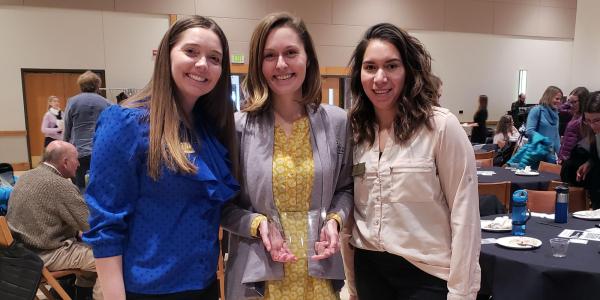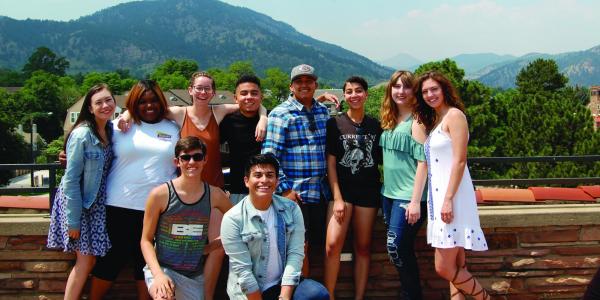‘Learning hip-hop can give engineering students an opportunity to get out of the lab and use a different part of their brain,’ instructor says
Students in the College of Engineering and Applied Science looking for a fun way to take a break from math and science have a new opportunity: Hip-hop.
Engineering students can now enroll in a new hop-hop class being offered by the CU Boulder Theatre and Dance department where they can learn hip-hop dance moves and get in shape while earning two hours of humanities & sciences credit.

Larry Southall, right, gives pointers to a hip-hop class. At the top of the page, some of his students puts his lessons literally into action. CU Boulder photos by Patrick Campbell.
Rhonda Hoenigman, senior instructor in computer science and an associate dean in engineering, and Larry Southall, instructor of dance, developed the hip-hop technique course, which is a special section of an existing course. Other sections will be taught next semester that aren’t restricted to engineering students.
The class starts in the spring 2020 semester. The instructors created the class exclusively for engineers to make hip-hop dancing a less intimidating experience. Engineering students won’t be dancing next to dance majors and will have the opportunity to interact with other engineering students in a different context.
“The idea for this class started because I took a hip-hop class as a faculty member,” Hoenigman said. “I have no dance experience, but I saw the class as great exercise and a way to try something that was completely unfamiliar to me. Learning hip-hop can give engineering students an opportunity to get out of the lab and use a different part of their brain.”
This is the second hip-hop class for Kevin Yang, a senior in computer science. Last semester he had some open slots in his schedule and looked around for a new class.
“This class is unique,” Yang said. “It’s a lot different from an engineering class. Collaboration with other students is strongly encouraged. It’s a fun way to meet people. I feel a sense of closeness to my classmates where I don’t necessarily feel that in a traditional class. Other people in class might be able to see the moves one or two times and get it. I go home and have to think about how (Southall) did that move. You have to put in the time, but I find it rewarding.”
Southall was born in the Bronx borough of New York. He has an MFA in dance from CU Boulder and is on the dance faculty. He teaches traditional hip-hop, different styles such as locking, popping, b-boying, b-girling, hip-hop party dance, and its history and multifaceted culture.
In addition to learning the dance, in his class students also learn about hip-hop’s origins, evolution, and the social, economic and political environment where it began.
“When we talk about hip-hop here, it’s different from what you see on TV,” Southall said, addressing students. “That’s rap culture. Rap is something you do. Hip-hop is something you live and breathe. I’m asking you to use the other part of your brain to stimulate and grow and make yourself stronger.”
Hip-hop emerged in the economically depressed South Bronx section of New York City in the late 1960s and early ’70s, as a response to dramatic socio-economic changes. When the white, middle-class population moved out of the area and into the suburbs in the 1950s and ’60s, the remaining population was primarily black and Hispanic.
Learning hip-hop can give engineering students an opportunity to get out of the lab and use a different part of their brain.”
The construction of the Cross Bronx Expressway that runs through minority neighborhoods devastated the inner-city areas in its path from 1948 to 1963. In the late ’60s and ’70s, an arson epidemic swept through the Bronx, leaving burned out buildings in its wake.
Urban decay, rising crime and poverty spurred young people in the South Bronx to look for creative ways to express themselves through art, music and dance as a way to find wellness for themselves.
“Hip-hop came out of the South Bronx with people trying to get out of gangs and avoid that violent lifestyle,” Southall said.
“There were no social services; Mother Teresa came to visit the children. So, people at that time wanted something to keep themselves from falling through the cracks. Hip-hop was it. I want students to understand the difference between what you see commercialized and commodified versus real hip-hop culture. Within that context, I teach the culture of the dance. I tell my students it’s OK to come in and struggle, because hip-hop is hard, but you will get there. Students coming in think we’re just going to dance, but no, they’re going to learn where it started, who started it and why we do this.”
For more information, contact Rhonda.Hoenigman@colorado.edu or Erika.Randall@colorado.edu. To enroll, contact Stacy.Norwood@colorado.edu.



